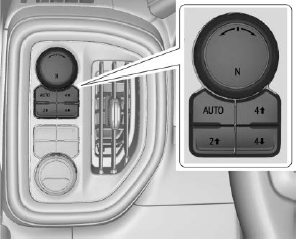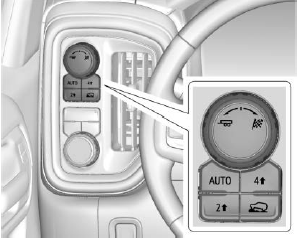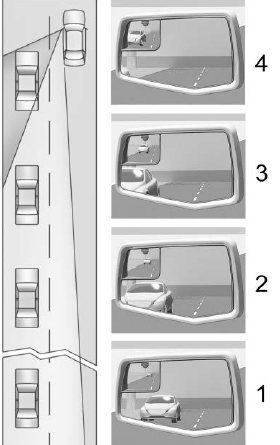Chevrolet Silverado: Driving and Operating / Drive Systems
Four-Wheel Drive
If equipped, four-wheel drive engages the front axle for extra traction.
Read the appropriate section for transfer case operation before using.
Caution
Do not drive on clean, dry pavement in
 m and
m and
 n (if equipped) for an extended period
of time. These conditions may cause premature wear on the vehicle’s powertrain.
n (if equipped) for an extended period
of time. These conditions may cause premature wear on the vehicle’s powertrain.
Driving on clean, dry pavement in  m or
m or  n may:
n may:
- Cause a vibration to be felt in the steering system.
- Cause tires to wear faster.
Warning
If equipped with four-wheel drive, the vehicle will be free to roll if
the transfer case is in N (Neutral), even when the shift lever is in P (Park). You
or someone else could be seriously injured. Be sure the transfer case is in a drive
gear — 2  , 4
, 4
 , or 4
, or 4
 — or set the parking brake before placing
the transfer case in N (Neutral). See Shifting Into Park.
— or set the parking brake before placing
the transfer case in N (Neutral). See Shifting Into Park.
Caution
Extended high-speed operation in 4
 may damage or shorten the life
of the drivetrain.
may damage or shorten the life
of the drivetrain.
An engagement noise and bump is normal when shifting between 4
 and 4
and 4
 or N (Neutral), with the engine running.
or N (Neutral), with the engine running.
Shifting into 4  will turn Traction
Control and StabiliTrak/Electronic Stability Control (ESC) off. See Traction Control/Electronic
Stability Control.
will turn Traction
Control and StabiliTrak/Electronic Stability Control (ESC) off. See Traction Control/Electronic
Stability Control.
Automatic Transfer Case
Two-Speed Transfer Case

If equipped, the transfer case controls are used to shift into and out of four-wheel drive.
To shift the transfer case, press the desired button. The graphic in the instrument cluster will flash while a shift is in progress. The graphic displayed will change to indicate the setting requested.
When the shift is complete the graphic will stop flashing. The DIC message turns off once the shift is complete. If the transfer case cannot complete a shift request, it will go back to its last chosen setting.
The settings are:
N (Neutral) : Use only when the vehicle needs to be towed. See Recreational Vehicle Towing or Towing the Vehicle.
2  (Two-Wheel Drive High)
: Use for driving on most streets and highways. The front axle is not engaged.
This setting provides the best fuel economy.
(Two-Wheel Drive High)
: Use for driving on most streets and highways. The front axle is not engaged.
This setting provides the best fuel economy.
AUTO (Automatic Four-Wheel Drive) : Use when road surface conditions are
variable. When driving in AUTO, the front axle is engaged, and the vehicle's power
is sent to the front and rear wheels automatically based on driving conditions.
This setting provides slightly lower fuel economy than 2
 .
.
4  (Four-Wheel Drive High)
: Use this setting when extra traction is needed, such as when driving on snowy
or icy roads, when off-roading, or when plowing snow.
(Four-Wheel Drive High)
: Use this setting when extra traction is needed, such as when driving on snowy
or icy roads, when off-roading, or when plowing snow.
4  (Four-Wheel Drive Low) :
This setting engages the front axle and delivers extra torque. Choose 4
(Four-Wheel Drive Low) :
This setting engages the front axle and delivers extra torque. Choose 4
 when driving off-road in deep sand,
deep mud, or deep snow, and while climbing or descending steep hills. While driving
in 4
when driving off-road in deep sand,
deep mud, or deep snow, and while climbing or descending steep hills. While driving
in 4  , keep vehicle speed below 72 km/h
(45 mph).
, keep vehicle speed below 72 km/h
(45 mph).
Shifting into 4  will turn Traction
Control and StabiliTrak/ESC off. See Traction Control/Electronic Stability Control.
will turn Traction
Control and StabiliTrak/ESC off. See Traction Control/Electronic Stability Control.
Shifts between 2  , 4
, 4
 , and AUTO
, and AUTO
Any of these shifts can be made at normal driving speed.
The actual 4x4 shift request is only made after the button is released. The 4x4 graphic will remain flashing until the shift request has completed. A DIC message displays to indicate that the 4x4 transfer case has been requested to shift to the new desired state.
Once the 4x4 shift has completed, the DIC message disappears, the 4x4 graphic stops flashing, and the current setting is indicated.
When a shift to 2  is completed successfully
while in P (Park), the parking brake will engage. To resume driving, shift the transmission
to the desired gear and manually release the parking brake or press the accelerator
pedal to begin driving. See Electric Parking Brake.
is completed successfully
while in P (Park), the parking brake will engage. To resume driving, shift the transmission
to the desired gear and manually release the parking brake or press the accelerator
pedal to begin driving. See Electric Parking Brake.
If equipped, use 4  , AUTO, or 4
, AUTO, or 4
 to provide additional traction when
parking on a steep grade with poor traction such as ice, snow, mud, or gravel.
to provide additional traction when
parking on a steep grade with poor traction such as ice, snow, mud, or gravel.
Shifting Into 4 
1. The ignition must be on and the vehicle must be stopped or moving less than 5 km/h (3 mph) with the transmission in N (Neutral). It is best for the vehicle to be moving 1.6 to 3.2 km/h (1 to 2 mph).
2. Press 4  . The actual 4x4 shift
request is only made after the button is released. The 4x4 graphic will remain flashing
until the shift request has completed. A DIC message displays to indicate that the
4x4 transfer case has been requested to shift to the new desired state.
. The actual 4x4 shift
request is only made after the button is released. The 4x4 graphic will remain flashing
until the shift request has completed. A DIC message displays to indicate that the
4x4 transfer case has been requested to shift to the new desired state.
Once the 4x4 shift has completed, the DIC message disappears, the 4x4 graphic stops flashing and the current setting is indicated.
If vehicle speed is higher when shift request occurs, a DIC message displays. Reduce vehicle speed.
If the transmission is not in N (Neutral) when shift request occurs, a DIC message
displays. The vehicle will allow 20 seconds for the shift to occur. After this time,
a graphic in the instrument cluster will indicate that the transfer case is in 4
 .
.
Caution
Shifting the transmission into gear before the requested mode indicator light has stopped flashing could damage the transfer case.
If the transmission is not shifted into N (Neutral) or the vehicle has not slowed to 5 km/h (3 mph) within 20 seconds, the transfer case will remain in its original state. This will be indicated in the instrument cluster.
With the vehicle moving less than 5 km/h (3 mph) and the transmission in N (Neutral), attempt the shift again.
Shifting Out of 4 
1. The vehicle must be stopped or moving less than 5 km/h (3 mph) with the transmission in N (Neutral) and the ignition on. It is best for the vehicle to be moving 1.6 to 3.2 km/h (1 to 2 mph).
2. Press 4  , AUTO, or 2
, AUTO, or 2
 . The actual 4x4 shift request is only
made after the button is released. The 4x4 graphic will remain flashing until the
shift request has completed. A DIC message displays to indicate the state of the
request.
. The actual 4x4 shift request is only
made after the button is released. The 4x4 graphic will remain flashing until the
shift request has completed. A DIC message displays to indicate the state of the
request.
Once the 4x4 shift has completed, the DIC message disappears, the 4x4 graphic stops flashing, and the current setting is indicated.
If vehicle speed is higher when shift request occurs, a DIC message displays. Reduce vehicle speed.
If the transmission is not in N (Neutral) when shift request occurs, DIC messages
will display. The vehicle will allow 20 seconds for this shift to occur. After this
time, a graphic in the instrument cluster will indicate that the transfer case is
in 4  .
.
Caution
Shifting the transmission into gear before the requested mode indicator light has stopped flashing could damage the transfer case.
If the transmission is not shifted into N (Neutral) or the vehicle has not slowed to 5 km/h (3 mph) within 20 seconds, the transfer case will remain in its original state. This will be indicated in the instrument cluster.
With the vehicle moving less than 5 km/h (3 mph), and the transmission in N (Neutral), attempt the shift again.
Shifting Into N (Neutral)
To shift into N (Neutral):
- Start the vehicle.
- Shift the transmission to N (Neutral).
- Shift the transfer case to 2
 .
. - Apply the parking brake and/or brake pedal.
- Press 2
 five times in 10 seconds
until the N (Neutral) graphic starts flashing in the instrument cluster. When
the shift is complete, the graphic stops flashing. If the parking brake and/or
brake pedal is not applied within 20 seconds, the transfer case will remain
in the original state.
five times in 10 seconds
until the N (Neutral) graphic starts flashing in the instrument cluster. When
the shift is complete, the graphic stops flashing. If the parking brake and/or
brake pedal is not applied within 20 seconds, the transfer case will remain
in the original state. - If the transmission is not shifted into N (Neutral) or the vehicle has not slowed to 5 km/h (3 mph) within 20 seconds, the transfer case will remain in its original state. This will be indicated in the instrument cluster.
Shifting Out of N (Neutral)
To shift out of N (Neutral):
- Turn the ignition on with the engine off. See Ignition Positions (Keyless Access) or Ignition Positions (Key Access).
- Set the parking brake. See Electric Parking Brake.
- Shift the transmission to N (Neutral).
- Shift the transfer case to 2
 .
Transfer case shifts out of N (Neutral) can only be made into 2
.
Transfer case shifts out of N (Neutral) can only be made into 2
 . When the shift to 2
. When the shift to 2
 is complete, the graphic in the
instrument cluster will stop flashing. If the transfer case cannot complete
a shift, the graphic will return to the previously selected setting.
is complete, the graphic in the
instrument cluster will stop flashing. If the transfer case cannot complete
a shift, the graphic will return to the previously selected setting.
Single Speed Transfer Case

If equipped, the transfer case controls are used to shift into and out of four-wheel drive.
To shift the transfer case, press the desired button. The graphic in the instrument cluster will flash while a shift is in progress. The graphic displayed will change to indicate the setting requested.
When the shift is complete the graphic will stop flashing. The DIC message turns off once the shift is complete. If the transfer case cannot complete a shift request, it will go back to its last chosen setting.
The settings are:
2  (Two-Wheel Drive High) :
Use for driving on most streets and highways. The front axle is not engaged.
This setting provides the best fuel economy.
(Two-Wheel Drive High) :
Use for driving on most streets and highways. The front axle is not engaged.
This setting provides the best fuel economy.
4  (Four-Wheel Drive High) :
Use this setting when extra traction is needed, such as when driving on snowy or
icy roads, when off-roading, or when plowing snow.
(Four-Wheel Drive High) :
Use this setting when extra traction is needed, such as when driving on snowy or
icy roads, when off-roading, or when plowing snow.
AUTO (Automatic Four-Wheel Drive)
Use when road surface conditions are variable. When driving in AUTO, the front
axle is engaged, and the vehicle's power is sent to the front and rear wheels automatically
based on driving conditions. This setting provides slightly lower fuel economy than
2  .
.
Shifts between 2  , 4
, 4
 , and AUTO
, and AUTO
Any of these shifts can be made at normal driving speed.
The actual 4x4 shift request is only made after the button is released. The 4x4 graphic will remain flashing until the shift request has completed. A DIC message displays.
Once the 4x4 shift has completed, the DIC message disappears, the 4x4 graphic stops flashing, and the current setting is indicated.
The actual 4x4 shift request is only made after the button is released. The 4x4 graphic will remain flashing until the shift request has completed.
A DIC message displays. Once the 4x4 shift has completed, the DIC message disappears, the 4x4 graphic stops flashing, and the current setting is indicated.
 Tow/Haul Mode
Tow/Haul Mode
The Tow/Haul Mode adjusts the transmission shift pattern to reduce shift cycling.
This provides increased performance, vehicle control, and enhanced transmission
and engine cooling when driving down steep hills or mountain grades, when towing,
or when hauling heavy loads...
 Brakes
Brakes
..
Other information:
Chevrolet Silverado 2019-2025 Owners Manual: Engine Compartment Fuse Block
If the vehicle has a diesel engine, see the Duramax diesel supplement. The engine compartment fuse block is in the engine compartment, on the passenger side of the vehicle for 1500 and driver side of vehicle for 2500/3500. Lift the cover to access the fuse block...
Chevrolet Silverado 2019-2025 Owners Manual: Service
All vehicles have a label underhood that identifies the refrigerant used in the vehicle. The refrigerant system should only be serviced by trained and certified technicians. The air conditioning evaporator should never be repaired or replaced by one from a salvage vehicle...
Categories
- Manuals Home
- 4th Generation Silverado Owners Manual
- 4th Generation Silverado Service Manual
- Maintenance Schedule
- Power Outlets
- Head-Up Display (HUD)
- New on site
- Most important about car
Blind Spot Mirrors
If equipped, there is a small convex mirror built into the upper and outer corner of the driver outside mirror. It can show objects that may be in the vehicle's blind zone.
Driving with the Blind Spot Mirror

Actual Mirror View
When the approaching vehicle is a long distance away, the image in the main mirror is small and near the inboard edge of the mirror. As the vehicle gets closer, the image in the main mirror gets larger and moves outboard. As the vehicle enters the blind zone, the image transitions from the main mirror to the blind spot mirror. When the vehicle is in the blind zone, the image only appears in the blind spot mirror.